1. Avoid placing furniture in chat areas:
When arranging your living room furniture, ensure that sofas and chairs are placed facing each other to facilitate conversation. In larger spaces, you can create multiple chat areas within one room.
2. Don’t push furniture against the wall:
If you want your room to appear bigger, avoid pushing all the furniture against the wall. This can create a disjointed feel. Instead, pull furniture away from the walls to create more balanced conversation areas. Even in smaller spaces, you can arrange furniture to suit the size of the room.

3. Consider practicality:
Arrange furniture in a way that allows for easy placement of drinks and displays of food in the kitchen. In addition to decorating, prioritize the practicality of furniture. For example, include a small shelf near the entrance to store daily items such as shoes, bags, and keys.
4. Focus on one focal point:
Each room should have a focal point to create a central area for furniture placement and decoration. Avoid decorating around multiple focal points, as this can make the room feel cluttered and confusing. Selectively decorate the room to create an elegant and balanced space.
5. Ensure ample passage space:
Avoid blocking pathways with furniture. Make sure furniture is arranged at eye level to allow for easy movement and clear views. Leave enough space for aisles to ensure comfortable navigation.
6. Achieve balance:
Evenly distribute furniture throughout the room to maintain balance. While complete symmetry is not necessary, it is important to have relative balance. For example, if there is a sofa on one side of the room, balance it with something of equal visual weight on the other side, such as another sofa, a pair of chairs, or a dresser.

7. Avoid covering windows:
Maximize natural light by avoiding placing furniture in front of windows. Blocking light can make the room feel smaller and cramped. If you have floor-to-ceiling windows and must place furniture in front of them, utilize mirrors, reflective surfaces, and smart lighting to maximize the remaining natural light in the room.
8. Consider activity zones:
When arranging furniture, take into account the different activity zones in the room. For example, reserve the study area for children or personal office space in the bedroom to ensure concentration. Customize the furniture arrangement, seating, lighting, and space to accommodate the specific needs of each activity and reflect the flexibility of the space.
Source: VOV






































